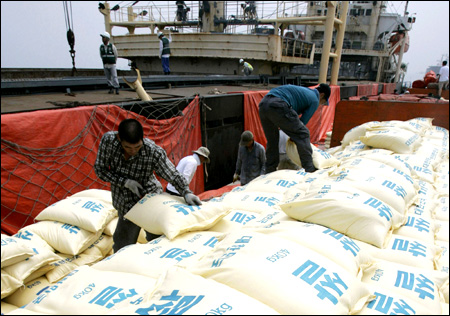Korea Times
Andrei Lankov
8/19/2007
Sometimes even Stalinist propaganda tells the truth. When the North Korean newspapers occasionally told grossly exaggerated horror stories about South Korean inflation, they stressed that nothing like that could possibly happen in North Korea. This was the case indeed. For nearly half a century, from the late 1950s to the late 1980s retail prices in North Korea remained essentially unchanged. One kilogram of rice cost 0.08 won in 1960. It was still the same price in 1990.
This was possible because almost nothing was actually “sold’’ in North Korea. Communist states often rationed goods distributed through retail trade, but in most cases it was only a handful of most prestigious goods that were subjected to rationing _ like, say, cars. North Korea went much further: by the early 1970s, retail trade in the North ceased to exist, being completely replaced by an elaborate public distribution system. Rations depended on a type of work performed, but also on one’s position within a complicated hierarchy of social groups, as well as one’s place of residence (inhabitants of major cities, and Pyongyang in particular, enjoyed much better rations than those in the countryside).
There were some markets, of course, barely tolerated by the government. But until the late 1980s markets were small, with their trade volume being almost negligible. It seems that most people were reasonably satisfied with what they could get from the state distribution system _ of course, it helped that they knew next to nothing about the situation in other countries, so they could not compare.
The situation began to change around 1990 when the old distribution system collapsed under the pressure of an economic crisis. From 1993-94 there were increasing problems with rations, and from around 1996 rations pretty much stopped altogether. Some food was still distributed in major urban centers, but even there the distributed amount was so meager that nobody could survive on rations alone. A large-scale famine ensued, with at least half to one million dead (the oft-cited figure of three million victims seems to be an exaggeration).
People turned to trade and handicrafts, and with this arrival of a market economy inflation became a North Korean phenomenon as well. Even in the 1980s market prices exceeded the official prices in the state shops. By the mid-1990s, the difference was much greater. In theory, rice still cost 0.08 a kilo, but by 2000 its price on the market reached 45-50 won. Official wages remained unchanged, however, so around 2001 the average salary was approximately 20 times less than the income necessary for physical survival. People had no choice but to augment their income.
The government understood that there was no way to restore the old system: a decade of economic crisis had undermined the basic machinery of distribution and obviously the system was beyond repair. Thus, in 2002 the much trumpeted “July 1 Reforms” were introduced.
It’s difficult to describe these measures as “reforms”–the government simply gave official recognition to the situation which had existed for quite a few years.
The distribution system (long defunct) was curtailed. There was a dramatic increase in the retail prices of basic goods and services _ obviously in an attempt to approximate the prices of the market. Thus, that one-kilo of rice which cost 0.08 won since July cost 44 won.
Wages increased as well. Obviously, the wage increase was not even, and some groups have gained _ or lost _ more than others. It was estimated that the average increase in wages has been approximately 2500 percent (that is, 25 times). At the same time, prices have increased 3000-4000 percent (that is, 30-40 times). This necessitated the issue of 1000 won bills _ the largest denomination in North Korean financial history since the 1959 currency reform. Later, 5000 won bills were issued as well.
But the measures had another effect. The increase in salaries meant that the market was instantly flooded with cash. Needless to say, the only outcome could be inflation. Some people speculated that this was the intention of the Pyongyang leaders who hoped to kick-start the economy in such a way. Perhaps. But I would not be surprised if in 15 or 20 years down the track we learn from interviews and talks with the planners of this reform that they did not really expect inflation. Pyongyang economic managers have not had much exposure to market theory, and are sometimes very naive in their understanding of these questions.
Indeed, by October 2002 the market price of rice had increased to 120 won per kilo. In 2003, the price doubled to 250-300 won, and now it is about 1000 won. Inflation has become a part of North Korean life.
What will happen next? Will the North Korean leaders manage to stabilize the situation, or will a new wave of economic crisis wipe out the entire North Korean system? We do not know yet. But it is clear that there is no return to old days when a kilo of rice could be had for 0.08 won _ that is, if you were lucky enough to live in an area where they distributed grain rations in rice, not in maize.

